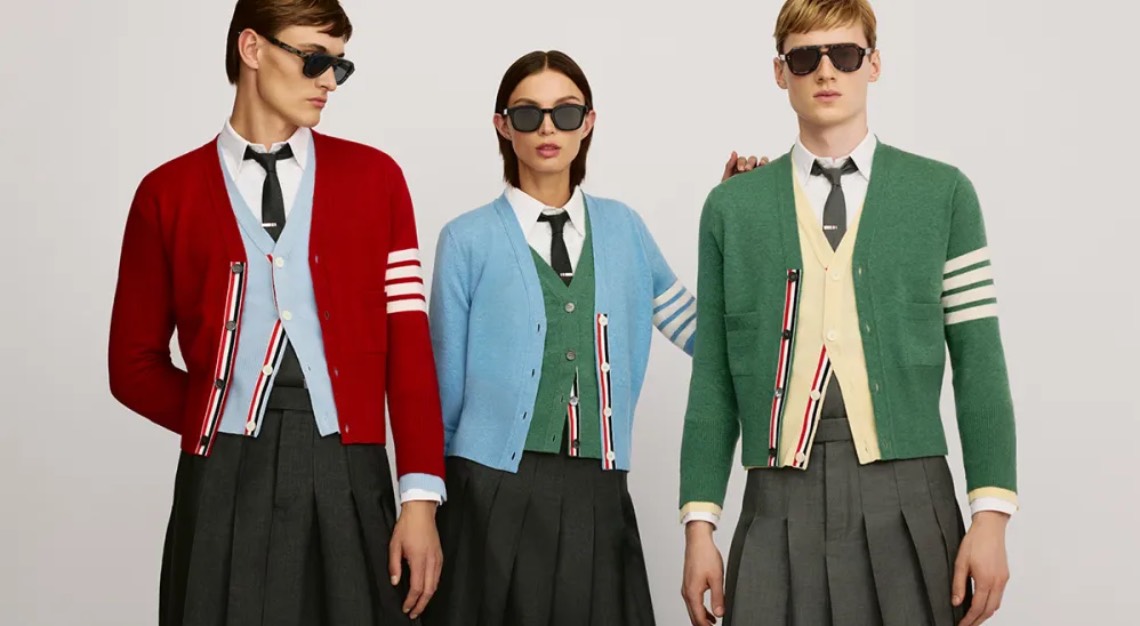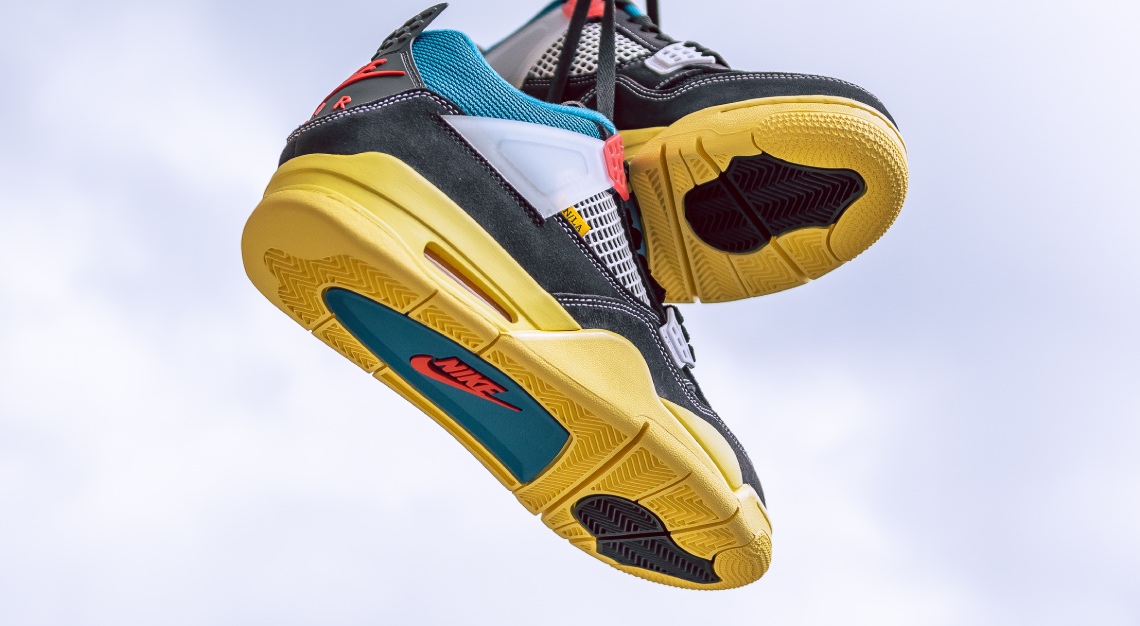Norbert Stumpfl is behind Brioni’s reemergence as the arbiter of elegance. And his timing is impeccable
Norbert Stumpfl is standing on a rooftop terrace off Rome’s Piazza Navona on a scorching summer day, surveying the ancient cityscape with the critical eye of a designer. “Rome has a lot of beauty,” the Austrian-born transplant, who has also lived for long stretches in both London and Paris, concedes. But, unusually, he finds that the bounty of classical wonders can grow a bit stale: “They don’t really change a lot.” After all, it’s not called the Eternal City for nothing.
The Italian capital’s immutable nature may be its defining feature, but Stumpfl has brought seismic change to at least one Roman landmark. Since taking the helm as Brioni’s creative director in 2018, he has dusted off the colossus of Italian tailoring and steadily, subtly – but firmly – imbued it with new life. Rather than simply strip it down to studs and rebuild it without a thought for its place in history, as one of his predecessors attempted with disastrous consequences, he has faithfully restored the brand, managing to make elegance relevant for today.
“I want to innovate and continue the story a little bit, because I think there is so much there,” says the 44-year-old designer, who helped revive moribund menswear lines at Lanvin and Balenciaga. Speaking in a hushed tone almost drowned out by the cacophony of the streets below, Stumpfl may be reserved but he doesn’t lack nerve. At a time when four-figure sneakers and haute couture hoodies are luxury fashion’s North Star, understatement is a statement in itself.
His designs, combining exceptional craftsmanship with a casual, toss-it-on attitude, bridge the ever-widening gap between traditional tailor shops and what’s coming down the runway, speaking to both worlds without conforming to either. From double-breasted suits rendered with all the softness of pajamas to precisely cut safari shirts in sumptuous silk twill, Stumpfl’s modernised wardrobe staples have won rave reviews from critics and attracted an influx of new patrons.
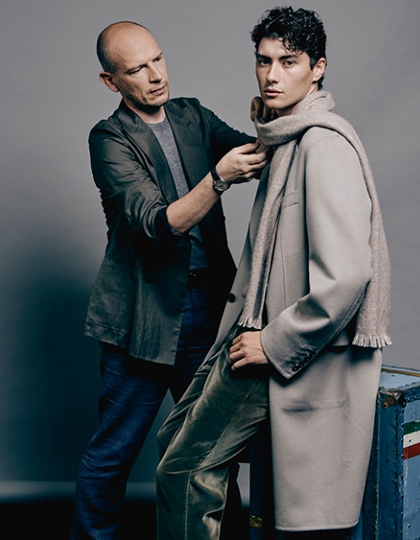
“10 years ago, men like our client had many more rules to follow,” he says. “I don’t think a 50-year-old needs to look like he’s not modern anymore.” The brand may be best known for outfitting masters of the universe in quintessential power suits, but Stumpfl is keenly aware that, today, power isn’t defined by a roped shoulder and a Windsor knot.
“If I just did classic men’s clothes, in the end, it gets boring,” Stumpfl says. Though acknowledging that exquisite tailoring is and always will be Brioni’s MO, he notes, “I don’t want to find myself at some point when fashion moves on and the lifestyle of our clients moves on.”
Stumpfl’s own outfit epitomizes sartorial power circa 2021: What appears to be a standard work shirt, albeit a very handsome one, is crafted from a double-faced Super 150s wool-and-silk suiting textile, which is meticulously split by hand to become airy and lightweight before being fashioned into a shirt – a process that Stumpfl notes is even more complex than constructing one of the brand’s suit jackets. Paired with linen trousers in a matching shade of cadet blue, it’s worn with all the ease of an old T-shirt.
“It’s all about this personal luxury, which people don’t see but gives you a kind of comfort,” Stumpfl says, describing both his own style and his vision for the brand. “Something which doesn’t shout, but you still know it’s there.”
Stumpfl was installed at Brioni after the house had endured a particularly rocky period. In 2012 descendants of the company’s founders sold it to Kering, owner of perpetually buzzy labels such as Gucci and Balenciaga. Brioni then went through a string of four design directors in five years, with results ranging from snoozy to shocking. Justin O’Shea, a design novice and street-style fop who’d been handed the reins in 2016, notoriously recruited Metallica as the poster stars for his rocker-infused revamp. During his tenure, O’Shea managed to entirely reshape the brand in a play for millennial hype: The classic looping script logo was replaced with a punky Gothic font, the wood-paneled boutiques were transformed with Instagram-friendly marble and chrome, and the clothes skewed more pimp than presidential (think red satin shirts, crocodile coats and an abundance of chinchilla). This “new” Brioni survived for only six months, but it very publicly exposed the brand’s identity crisis.
That Brad Pitt is now the face of the label says all one needs to know about Brioni in the Stumpfl era. After years of the actor politely declining the company’s advances, he reached out after seeing Stumpfl’s new direction to commission a bespoke tuxedo, and a muse was born. Pitt went on to collaborate with Stumpfl on BP Signature, a spring ’21 capsule collection of his favorite pieces – washed-silk utility jackets, a cashmere polo, a re-creation of the tux he wore to accept his Oscar for best supporting actor in 2020 – and provided the designer with one of his proudest moments since taking the job.
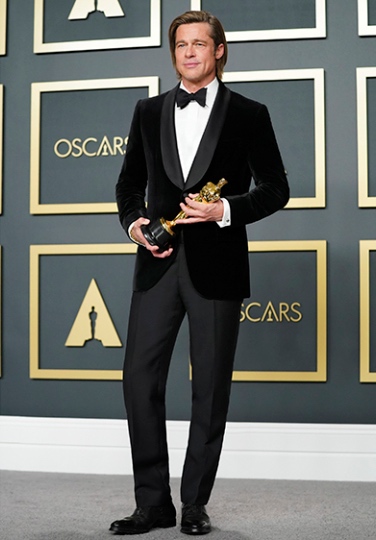
During the photo shoot for the collection’s ad campaign, Pitt’s assistant summoned Stumpfl into the actor’s dressing room. “It was like, ‘Hmm, what did I do wrong?’ ” the designer recalls. “Then he’s like, ‘Norbert, I wanted to tell you: Since I’m wearing Brioni, I look great but I feel amazing. I just wanted to thank you for doing these kinds of clothes.’ I was crying!”
Stumpfl displays an earnest wonderment at where he’s found himself, revealing glimpses of the boy who grew up on a farm in Austria. “I was a little bit of an outsider… not like the other boys who were more into football,” he says. “I always knew I would leave eventually.” Fate provided his ticket out.
A school close to Stumpfl’s home happened to have a vocational program dedicated to tailoring. He enrolled at 13 out of convenience and fell in love with the craft of menswear. At the same time that he was making his own suits to wear to school, Stumpfl began idolizing the agenda-setting designs of Helmut Lang and Jil Sander. He tracked down the closest boutique selling Lang and took a job nearby, saving his wages to buy a Lang of his own. After moving to upstate New York to sharpen his English (and sneaking down to Manhattan to go clubbing), Stumpfl landed in London to attend Central Saint Martins, the influential design school.
“One of the first things I remember being amazed by was Norbert’s wardrobe. It was impeccable,” says fellow designer Daphne Karras, who met Stumpfl when they were students and has been his wife for 14 years. “He always had this taste of classic modernity; from the moment I met him, that aesthetic was there.”
Danielle Scutt, another classmate, similarly recalls being stunned to see Stumpfl show up one day with a Cartier Pasha on his wrist: “I mean, we were students! And then he has this watch with a sapphire on it?” As Karras points out, “He worked every weekend for this. His love of beauty wasn’t handed to him. It’s something he educated himself on. He really found pleasure in discovering this universe.”
Stumpfl says he’s always been enamored of “extreme luxury.” He still wears that Pasha and has added further blue-chip timepieces to his collection, such as an early Audemars Piguet Royal Oak and a 1960s Heuer chronograph. A self-professed minimalist, he is diligent about buying only pieces with staying power, from Arne Jacobsen chairs to Ellsworth Kelly lithographs. It’s this obsession with quality that first led him to Brioni, becoming a customer before he would make the house his home.
From the beginning, Stumpfl’s tailoring background made him stand out from the fashion pack. While at Saint Martins, a friend working at Alexander McQueen called him when, the night before a campaign shoot, all of the clothes has to be taken down in size. Stumpfl delivered, and McQueen, himself a Savile Row alumnus, was so impressed that he enlisted Stumpfl to tailor pieces for his infamous runway shows.
Soon after completing school in 2005, Stumpfl was tapped by Lanvin creative director Alber Elbaz to be the number two on the team relaunching the brand’s menswear. The late Elbaz, whose womenswear was celebrated for being as wearable as it was imaginative, taught Stumpfl the importance of staying grounded in reality.
“He would always tell me: ‘A lot of designers are making things that, in terms of food, would be like foie gras on top of caviar with mozzarella—really good ingredients but too much,’ ” Stumpfl recalls.
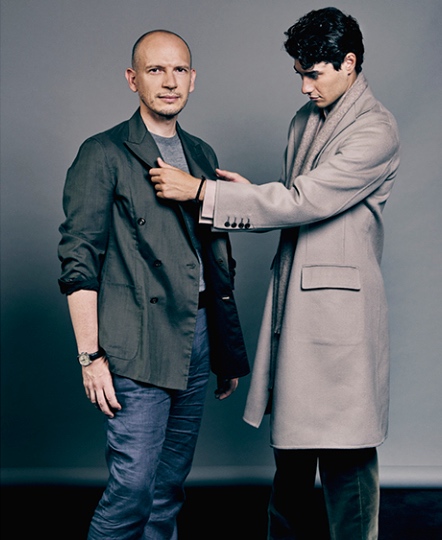
He left Lanvin in 2014 to head up Balenciaga’s menswear during Alexander Wang’s tenure. After two years, Wang was traded out and Stumpfl worked briefly with Demna Gvasalia, then moved to Louis Vuitton under Kim Jones, who’d been impressed by Stumpfl’s student designs when he was a visiting tutor at Saint Martins. Before Jones moved to Dior, he connected Stumpfl with Haider Ackermann, Berluti’s recently appointed creative director. “It was a breath of serenity when he entered,” says Ackermann, describing Stumpfl’s precision and “immaculate proportions” as his greatest talent. “He’s quiet but he’s confident, and that’s what luxury is about… this elegance of discretion.” Beautiful as Berluti was under them, fashion’s musical chairs struck again after barely one year.
Although he has been a repeat victim of the industry’s insatiable appetite for novelty, Stumpfl doesn’t harbor any bitterness. But he was weary enough to turn down several offers, uninterested in attempting to create next season’s hottest sneaker. When Brioni came calling, however, it instinctively felt like a match.
Founded in 1945, Brioni pioneered menswear as we know it. The Roman tailoring firm was the first to put men on the catwalk, in 1952, thumbing its nose at the industry’s sobriety and giving men permission to have fun with fashion. Press at the time heralded Brioni as menswear’s Dior, its influence as widespread as the French couturier’s New Look was for women. As guys traded in their fatigues for body-skimming suits, Brioni became the bellwether for a new breed of male refinement.
“The founders were using fabrics that were unheard of in menswear,” says Stumpfl, an astute student of the archives. “It was completely going in a different direction of what was happening at the time… almost like Demna at Balenciaga, something really on the edge,” he continues, referencing Balenciaga’s current creative director, a primary architect of the high-fashion hoodie craze.
While such enfants terribles claimed the mantle of cool, Brioni’s early reputation for trendsetting settled into one for beautifully made, if a bit uninspired, business suits. In today’s fashion landscape, a bastion of tailored sophistication risks going the way of the frock coat, but, perhaps counterintuitively, taking over a collection in crisis has its appeal. “It’s kind of nice to step into these companies where people don’t expect anything of you,” Stumpfl says, comparing Brioni’s muddled identity to Lanvin’s dormant menswear before he started. “You see the change that you can bring as a designer.”
“I want people to recognize a Brioni man on the street and say, ‘Oh, he looks great,’ but they shouldn’t know it’s Brioni.”
Stumpfl has not only righted the ship, he’s steered it into new waters. Fitting bespoke clients in London last year, he was surprised to find guys as young as 19 coming in alongside the captains of industry he’d expected. Perhaps more impressively, a range of equally successful women have joined the ranks of Brioni shoppers since Stumpfl took charge. “He brings a nobility to Brioni,” says Ackermann, who notes that Stumpfl has a knack for making “the perfect piece,” such as Pitt’s tuxedo. Heady as Brioni’s wares may be, Stumpfl isn’t too precious about them – a point that has been underscored by his fashion week presentations. For his spring 2020 collection that was revealed to the media a year earlier, he staged an assortment of tableaux with mannequins cheekily acting out a day in the life of the Brioni man, from soaking in a bath drawn by a woman wearing boxers, his silk pajamas at the ready, to crashing on the couch after a black-tie gala, with numerous high jinks in between.
“He’s practical but he has a more playful, fun side,” says Mattias Karlsson, a stylist who’s known Stumpfl since his Saint Martins days and has worked on every Brioni presentation since the designer started. “When we’re working, it’s always very spontaneous. It’s a joyful process.” Avoiding self-serious fashion shows with Adonises strutting down a catwalk is very much intentional. Stumpfl sees it as a typically Italian attitude: “They just put the clothes on and go on with their life. The clothes can be a little creased, it doesn’t matter.”
It’s Stumpfl’s lack of pretension that gives once-buttoned-up Brioni a sense of levity and, more vitally, modernity. “I have both sides in me,” the designer reflects, his measured expression curling into a grin. “I’m quite quiet and traditional, but then on the other side, I’m also quite fearless.”
The latter has been most apparent in Stumpfl’s eccentric eveningwear, such as the 24-karat-gold-plated tuxedo that Leslie Odom Jr. sported at this year’s Academy Awards. While it may seem counter to the subtle elegance of his daywear, Stumpfl points out that avant-garde dinner jackets are what first put Brioni on the map: “Having this history, I’m allowed to dare.”
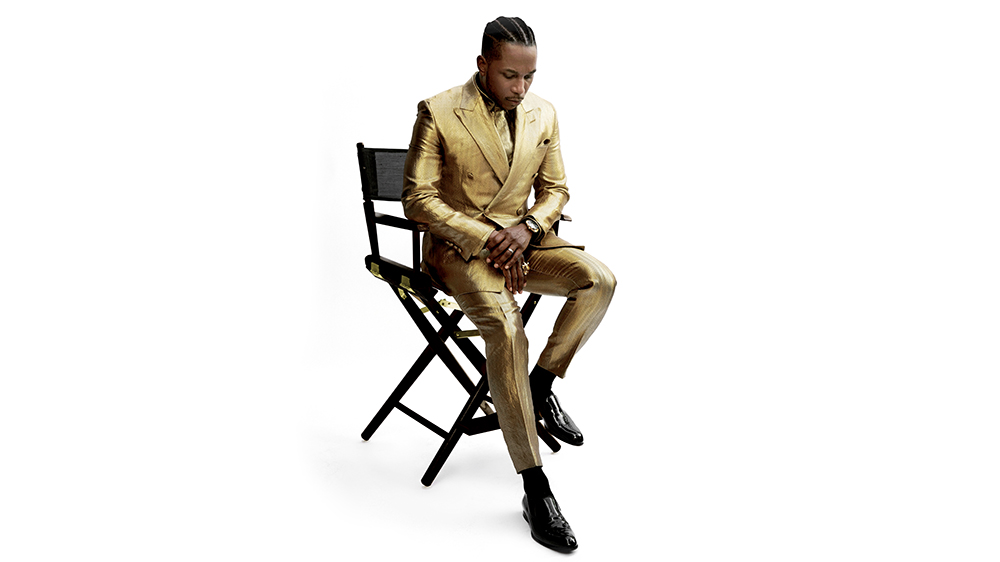 Leslie Odom Jr. in a high-tech gold suit at the Oscars this year.
Leslie Odom Jr. in a high-tech gold suit at the Oscars this year.
That tuxedo is one of countless examples of the painstaking textile development that has become Stumpfl’s signature. (The electromagnetic technology that yielded the gilded yet supple fabric has been employed by only one other firm: the Vatican.) Karras, who is now a consultant designing Brioni’s knitwear and serving as Stumpfl’s unofficial right hand in R&D, says that although he favors classic silhouettes, “where he gets really creative is in how things are made. He’s almost working more as an architect than a designer.”
While Stumpfl expected some of the more outré pieces, such as a dinner jacket in an opulent floral jacquard, to simply be eye candy for store windows, he reports that the item sold out – and this was during the height of the pandemic. Explaining the allure of this particular piece – its fabric is woven on a Venetian loom dating back to the 17th century, requiring three months of milling to produce enough yardage for a single jacket – Stumpfl visibly tears up.
“It was, like, 20 tailors around, looking at this jacket being made, and they were like, ‘Wow, this is Brioni,’” the designer says. “This is what I love.”
At Stumpfl’s home, it becomes clear that an appreciation for craft, both old and new, extends to all corners of his life. The wisteria-clad townhouse in Rome’s bohemian Monti district combines ancient architecture with sleek midcentury furnishings in the same unfussy style that marks his creations. In bare feet, the designer glides about the open kitchen, vetoing candles for the table setting while preparing a simple supper of pasta with fresh tomatoes like a true Italian. (The chocolates served for dessert, however, show he hasn’t lost his Austrian sweet tooth.)
Modernist that he is, Stumpfl still marvels at the beauty he encounters on his daily walk to Brioni’s headquarters – passing the majestic fountains of Piazza della Repubblica and the gilded mosaics of Santa Maria Maggiore – saying, “Sometimes I feel like I’m on a holiday which continues.”
After more than a decade in Paris, Stumpfl has come to appreciate the relaxed pace of Roman life. “It’s like a little village,” he says. “It kind of suits me now.” And although he’d been concerned about relocating his two daughters, they’re happy to have traded a concrete playground in the Marais for the gardens of Villa Borghese. (“Every day, they come home dirty – like, full of mud.”)
While this is the first time that Stumpfl and Karras have been on the same design team, it’s something of a reunion – the couple met sharing a worktable at school. “She’s somebody who I can trust completely. I think she’s much more talented than I am,” he says. “Because there is a lot of stress, if you can trust someone a hundred percent, you have more eyes on everything.”
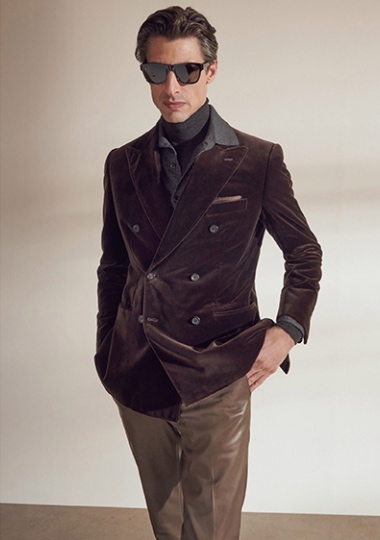
But that’s not to say Stumpfl doesn’t have deep respect for the wealth of knowledge in Brioni’s atelier. “He’s really a collaborator,” Karras says of his leadership. “When he likes something, he likes it. And if he doesn’t, he doesn’t. But even when he disagrees with you, he’s doing it in a way that’s soft and considerate and eloquent.”
Stumpfl is just as exacting when he’s off duty – he can spend hours tending to his orchids or his aquarium. The meditative upkeep of bonsai is a particular passion; he purchased one upon his arrival in Italy and, after three years of careful monitoring to ensure it would survive sweltering Roman summers, he only recently allowed himself to buy another. (“Super nerd!” he exclaims.) Discussing his horticultural pursuits, the otherwise sedate Stumpfl is as animated as he is when detailing technical tailoring feats. It makes sense: The invisible artistry of bonsai pruning isn’t all that different from the stealth luxury he’s brought to Brioni.
“I want people to recognise a Brioni man on the street and say, ‘Oh, he looks great,’ but they shouldn’t know it’s Brioni,” he says, in what marketing executives everywhere would see as blasphemy. Stumpfl is an adherent to the if-you-know-you-know school of chic, favoring clothing that is most appreciated by wearing it. “These guys don’t need to say they’re in Brioni – they’re not choosing it for that.”
He’s aware that the brand’s exquisitely understated offerings—and dizzyingly high prices – are not for everyone, and he wants to keep it that way. “It might be completely different from what my colleagues, other designers, are thinking,” he says, acknowledging that an instantly identifiable product is the Holy Grail for most brands – even Hermès has its Birkins. That might be the conventional logic, but “I’m the opposite.” Quiet as he may be, Stumpfl’s strategy has been validated. He has seen Roman style and conquered it.

